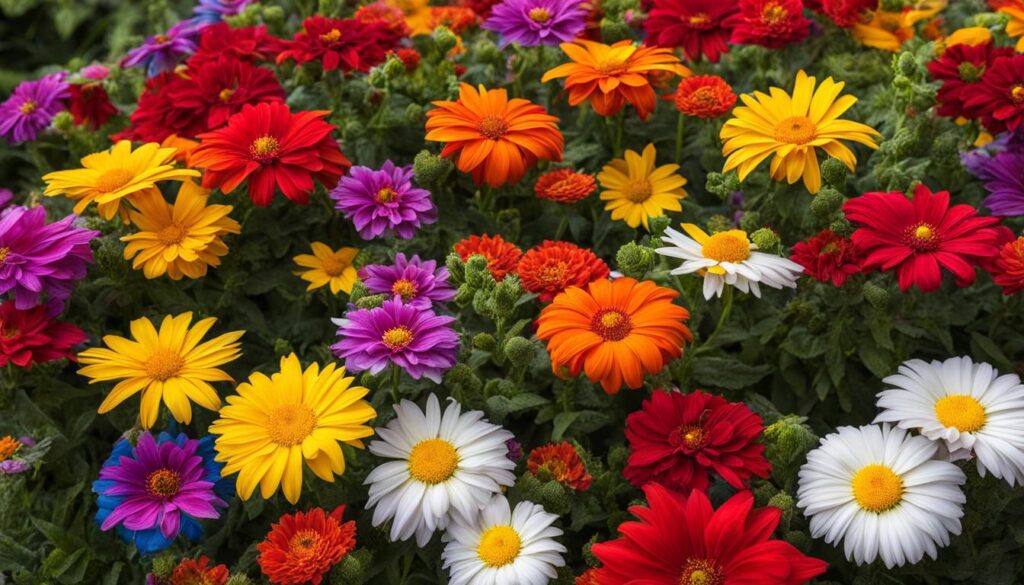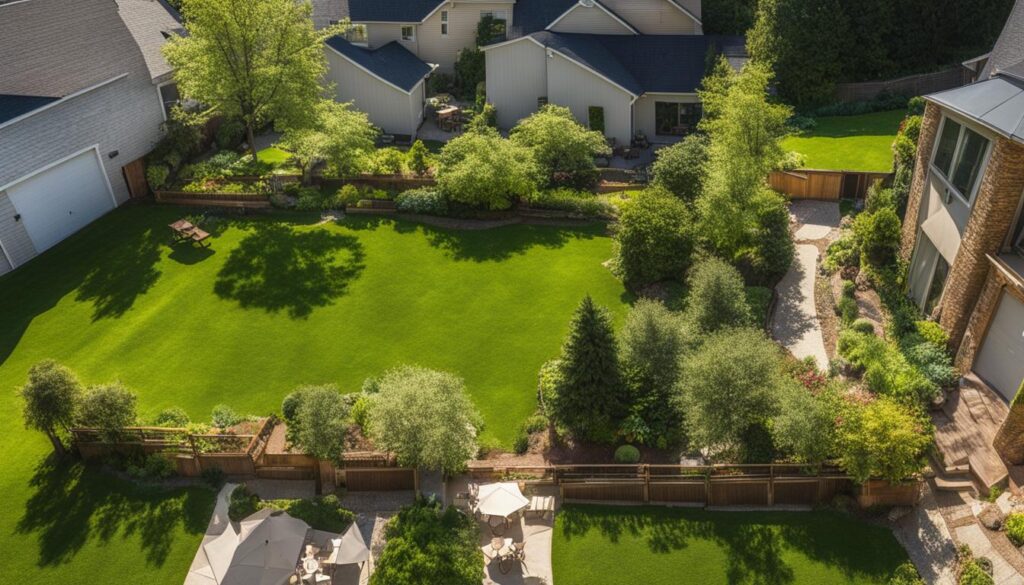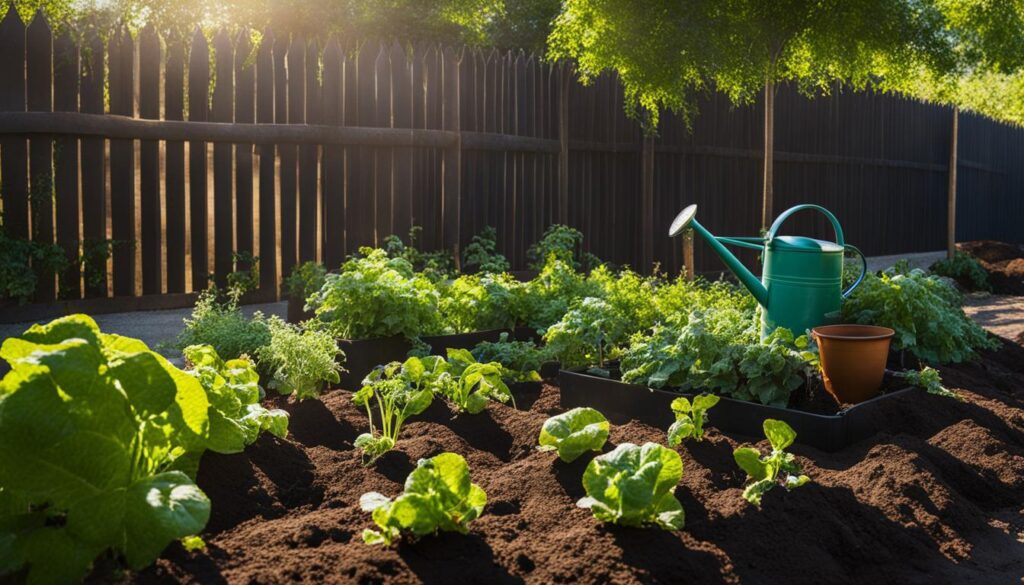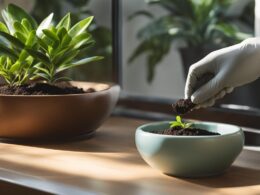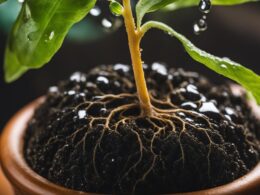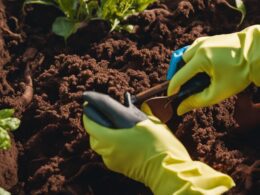Building healthy soil is crucial for successful gardening. By implementing the right practices, you can create a nutrient-rich environment that promotes plant growth and reduces the need for pesticides. In “The Art of Gardening: Building Your Soil” e-Book, you’ll learn various methods of composting, the importance of soil testing, how to interpret soil test results, the drawbacks of rototilling, the benefits of using mulch, and tips on choosing the right seeds and starting your own. This comprehensive guide offers practical advice and is beautifully illustrated by artist Deb Hamby.
Key Takeaways:
- Building healthy soil is essential for successful gardening
- Composting, soil testing, and mulching are effective methods for enriching garden soil naturally
- Starting seeds and choosing the right garden site are important factors for optimal gardening conditions
- Cultivating a bountiful harvest with vegetable gardening is rewarding and nutritious
- By enriching your garden soil naturally, you can promote healthy plants and sustainable gardening practices
The Benefits of Building Healthy Soil
Building healthy soil is the foundation of a successful garden. By nurturing your soil, you create an environment that promotes the growth of disease-resistant plants and reduces the need for chemical interventions. Healthy soil teaming with beneficial microorganisms helps break down organic matter and releases essential nutrients that plants need to thrive. By improving the soil structure, you also enhance its water-holding capacity, reducing the risk of waterlogged roots.
Organic gardening practices are closely linked to building healthy soil. By avoiding the use of synthetic fertilizers and pesticides, you create a more sustainable and environmentally friendly approach to gardening. Instead, through composting and mulching, you can naturally replenish the soil’s nutrients and improve its overall health. This not only benefits your plants but also contributes to the long-term health of the ecosystem in and around your garden.
Healthy soil minimizes the need for toxic pesticides and encourages a more sustainable, organic gardening approach.
When you invest time and effort into building healthy soil, you’ll reap the rewards with a more bountiful and nutrient-dense harvest. Disease-resistant plants are less susceptible to common garden pests and diseases, resulting in healthier and stronger plants. Organic gardening practices also prioritize the quality and flavor of the produce, as the plants have access to a rich and well-balanced range of nutrients from the soil. So not only will you enjoy the satisfaction of growing your own food, but you’ll also savor the delicious flavors of your homegrown vegetables.
| Benefits of Building Healthy Soil | Organic Gardening |
|---|---|
| – Promotes the growth of disease-resistant plants | – Avoids the use of synthetic fertilizers and pesticides |
| – Enhances soil structure and water-holding capacity | – Uses composting and mulching to naturally replenish soil nutrients |
| – Reduces the need for chemical interventions | – Supports the long-term health of the ecosystem |
| – Results in a more bountiful and nutrient-dense harvest | – Prioritizes quality and flavor of produce |
Methods for Enriching Your Garden Soil
In order to create a nutrient-rich environment for your garden, it is important to implement effective methods for enriching your soil naturally. The “The Art of Gardening: Building Your Soil” e-Book provides valuable insights and guidance on various techniques, including composting, soil testing, and mulching.
Composting
Composting is a highly effective way to recycle kitchen scraps and yard waste into nutrient-rich compost that can be added to your soil. By creating a compost pile or using a compost bin, you can break down organic matter and generate a rich fertilizer for your plants. Composting not only enriches the soil but also helps to promote healthy microbial activity, improve soil structure, and retain moisture.
Soil Testing
Understanding the nutrient levels in your soil is essential for making informed decisions about amendments. Soil testing provides valuable insights into the current state of your soil, including its pH level, nutrient content, and organic matter. By conducting regular soil tests, you can identify any deficiencies or imbalances and customize your fertilization approach accordingly.
Mulching
Mulching is another essential practice for enriching your garden soil. By applying a layer of organic mulch, such as wood chips or straw, to the surface of your soil, you can help retain moisture, suppress weed growth, and gradually improve the soil as the mulch breaks down. Mulching also acts as a natural insulation, protecting plant roots from temperature extremes and providing a habitat for beneficial soil organisms.
By incorporating these methods into your gardening routine, you can enhance the fertility and health of your soil, resulting in thriving plants and bountiful harvests.
| Method | Benefits |
|---|---|
| Composting |
|
| Soil Testing |
|
| Mulching |
|
Tips for Starting Seeds and Choosing a Garden Site
Starting plants from seeds can be a rewarding and cost-effective way to grow a diverse range of vegetables and flowers in your garden. Whether you’re a beginner or an experienced gardener, learning the proper techniques for starting seeds is essential to ensure successful germination and strong seedlings.
When starting seeds, it’s important to provide them with optimal conditions for germination. Choose a well-lit area, such as a sunny windowsill or a greenhouse, that receives at least 6-8 hours of sunlight a day. If natural light is limited, you can use artificial grow lights to supplement the lighting.
Container selection is also crucial when starting seeds. Use seed trays, peat pots, or recycled containers with drainage holes to prevent waterlogging and aid in root development. Fill the containers with a high-quality seed-starting mix that is sterile and well-draining.
Once your seeds have germinated and the seedlings have developed their first true leaves, it’s time to transplant them into larger containers or directly into the garden. Handle the delicate seedlings by their leaves to avoid damaging the stems. Harden off the seedlings by gradually exposing them to outdoor conditions, starting with a few hours a day and gradually increasing the duration over the course of a week.
Choosing a Garden Site
When selecting a garden site, several factors need to be considered to create optimal conditions for your plants to thrive. The following are key considerations when choosing a garden site:
- Sunlight exposure: Most vegetables require at least 6 hours of direct sunlight per day. Choose a site that receives ample sunlight to ensure healthy plant growth.
- Soil drainage: Avoid areas with poor drainage, as waterlogged soil can lead to root rot and other problems. Look for a site with well-draining soil or consider implementing raised beds or container gardening.
- Proximity to water sources: Water is essential for plant growth, so choose a site that is conveniently located near a water source for easy irrigation.
- Protection from strong winds: Strong winds can damage delicate plants and hinder their growth. Select a site that is sheltered or consider installing windbreaks to protect your garden.
| Site A | Site B | Site C | |
|---|---|---|---|
| Sunlight exposure | 6-8 hours of direct sunlight | 4-6 hours of direct sunlight | 8-10 hours of direct sunlight |
| Soil drainage | Well-draining soil | Heavy clay soil | Sandy loam soil |
| Proximity to water sources | Convenient access to water | Requires irrigation | Requires irrigation |
| Protection from strong winds | Natural windbreaks | Exposed to strong winds | Sheltered location |
“A garden site with good sunlight exposure, well-draining soil, convenient access to water, and protection from strong winds is ideal for growing a wide variety of plants.”
Cultivating a Bountiful Harvest with Vegetable Gardening
Vegetable gardening is not only a rewarding hobby but also a great way to add fresh, nutrient-dense produce to your meals. With the right techniques and knowledge, you can cultivate a bountiful harvest of delicious vegetables right in your own backyard. In “The Art of Gardening: Building Your Soil” e-Book, you’ll discover a wealth of information on vegetable gardening, from choosing the right varieties to nurturing your plants for optimal growth.
One of the key benefits of vegetable gardening is the ability to harvest nutrient-dense vegetables that are packed with vitamins, minerals, and antioxidants. Unlike store-bought produce, which may have traveled long distances and been picked before fully ripening, homegrown vegetables can be harvested at their peak flavor and nutritional content. This means you can enjoy the freshest, most flavorful produce while reaping the health benefits of a diet rich in vitamins and minerals.
To help you get started on your vegetable gardening journey, “The Art of Gardening: Building Your Soil” e-Book provides a comprehensive guide to different vegetable varieties and their specific growing requirements. Whether you’re interested in planting tomatoes, peppers, leafy greens, or root vegetables, you’ll find valuable tips on seed selection, planting techniques, and ongoing care. The e-Book also features ten mouthwatering recipes that showcase the incredible flavors of homegrown vegetables, inspiring you to get creative in the kitchen with your harvest.
Table: Common Vegetable Varieties and Their Growing Tips
| Vegetable | Growing Tips |
|---|---|
| Tomatoes | Plant in full sun, provide support for indeterminate varieties, and water evenly to prevent blossom-end rot. |
| Lettuce | Choose a variety suited to your climate, sow seeds in cool weather, and keep the soil consistently moist to prevent bolting. |
| Carrots | Plant in loose, well-draining soil, thin seedlings to avoid overcrowding, and water consistently to promote straight root growth. |
| Zucchini | Provide ample space for plants to spread, harvest young fruits to encourage continuous production, and monitor for pests like squash bugs. |
By following the advice and techniques outlined in the e-Book, you’ll be well-equipped to grow a thriving vegetable garden and enjoy a rich harvest of homegrown goodness. From crisp salads and vibrant stir-fries to hearty soups and flavorful side dishes, your vegetable garden will provide you with an abundance of fresh, nutritious ingredients that will enhance your culinary creations. Start your vegetable garden today and experience the joy of growing your own food.
How Can Building Garden Soil at Home Help with Year-Round Gardening?
Building a healthy garden soil at home is crucial for expert gardening year round. A nutrient-rich soil will help your plants thrive in all seasons, providing them with the necessary nutrients and improving water retention. Creating optimal soil conditions is key for maintaining a successful year-round garden.
Conclusion
Building garden soil is a crucial step in achieving healthy plants and practicing sustainable gardening. With the guidance and techniques provided in “The Art of Gardening: Building Your Soil” e-Book, you can create a thriving garden that yields lush and vibrant plants.
By focusing on enriching your soil naturally, you reduce the need for chemical pesticides and embrace a more organic and environmentally friendly approach. This not only benefits your plants but also promotes a sustainable gardening ecosystem.
Start building your garden soil today and enjoy the rewards of a bountiful harvest and nutrient-rich produce. With healthy soil as the foundation of your garden, you’ll experience the joy of nurturing plants that flourish and provide you with delicious homegrown vegetables.
FAQ
What are the benefits of building healthy soil?
Building healthy soil promotes vibrant and disease-resistant plants, reduces the need for pesticides, enhances water-holding capacity, and encourages sustainable, organic gardening.
What methods can I use to enrich my garden soil?
You can enrich your garden soil through composting, soil testing, and mulching. Composting recycles kitchen scraps and yard waste into nutrient-rich compost, soil testing helps you understand your soil’s nutrient levels, and mulching retains moisture and suppresses weeds.
How can I start seeds and choose a garden site?
The e-Book provides guidance on starting seeds, including proper germination, transplanting, and caring for seedlings. It also offers insights into choosing an ideal garden site, considering factors such as sunlight exposure, soil drainage, and proximity to water sources.
What can I expect from vegetable gardening?
Vegetable gardening can provide a bountiful harvest of nutrient-dense vegetables. The e-Book offers guidance on different vegetable varieties, planting techniques, and best practices for nurturing vegetables to their full potential.
Why is building garden soil important?
Building garden soil is crucial for successful and sustainable gardening. It creates a nutrient-rich environment, reduces reliance on chemical pesticides, and fosters a more organic and environmentally friendly approach to gardening.






